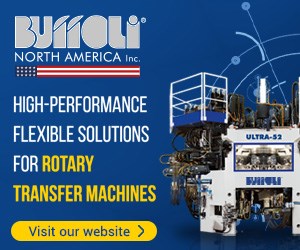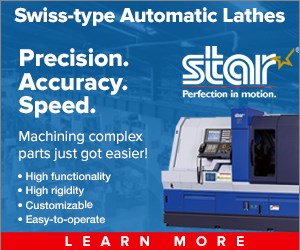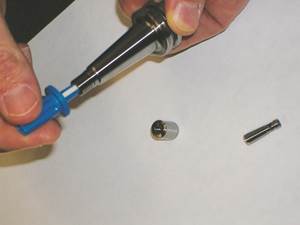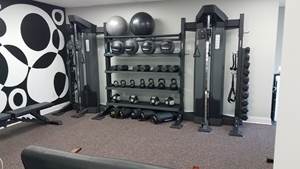
Email me at dkorn@productionmachining if you have advice to share relative to machining plastics. Source: PM
Although the majority of machining articles I write involve parts produced from metals, I have written a variety of plastics machining articles over the years, too. And how plastics can be finicky in their own ways to machine compared to metals.
Perhaps the most common plastic material I’ve learned about from machine shops and material producers is polyetheretherketone. This is commonly referred to as PEEK, but polyetheretherketone is fun to say quickly once you get used to it.
This material is produced in both industrial and medical grades. Because it is important to avoid material contamination, especially for medical grade PEEK, some shops dedicate the machine tool, fixturing and tools to machining only PEEK. It is also common for operators to wear gloves when handling PEEK to keep oils off the part surface.
PEEK typically is machined dry, using air blast for chip control, and its machinability is said to be similar to that of Delrin. It is also worth considering using chilled cooling methods such as compressed CO2 or dry ice blasting to reduce the chance of creating burrs on the part.
As one shop explained, when machining plastics such as PEEK, the tool and base part material take the heat instead of the heat coming out with the chip. The higher the base part material temperature, the more likely the cut material is to fray and stay connected to the part. Using cold air as the coolant combined with sharp, uncoated cutters reduces the likelihood of this happening.
In addition, medical-grade PEEK is expensive. For Swiss-type lathes, I’ve seen shops try to minimize the length of the barstock “remnant;” that is, the remaining end of the barstock that cannot be machined due to the distance between a Swiss-type’s main collet and signature guide bushing. Remnant length can range from 7 to 12 inches, which can be costly waste for shops purchasing their own material. To reduce remnant length to a length of perhaps just a couple inches, steel extensions can be created and screwed to the end of PEEK bars.
I’ve also visited shops that machine glass-filled plastics. In some cases, materials such as glass in fiber or mat form are added to plastics to improve insulating properties, dimensional stability and mechanical strength. However, this can lead to difficulty machining them. Optimal cutters for glass-filled plastics are said to have positive rake angles and very sharp cutting edges to cleanly cut glass filler while not burning the resin. Plus, tool coatings such as polycrystalline diamond (PCD) extend tool life in machining of abrasive glass filler. Because machining this material creates tiny chips and a good deal of dust, a dust collection system is recommended to minimize dust build up on machine components and maintain a clean facility.
Carbon-fiber-reinforced plastics are being used more these days, too, especially for aerospace applications. For these applications, waterjet or conventional milling operations might be used. One advantage of waterjet is that its abrasive garnet media serve as the high-pressure stream’s “cutting edges.” Because fresh media is continually introduced into the stream, the stream’s cutting edges are always sharp, minimizing the chance for delamination or leaving behind burred edges.
When milling is the only viable process, balanced, HSK shrink-fit toolholders can help to minimize tool runout and prevent cutters (primarily diamond-coated tools) from wearing non-uniformly. Because some composite workpieces are relatively thin, it can make sense to routinely alter the depth that a tool reaches through a workpiece to get the most out of a tool’s total available flute length.
If you machine plastics and have advice to share, please reach out to me. It’d be great to let our audience know about it.
Related Content
Tips for Troubleshooting and Repairing Chip Conveyors
A nonfunctioning chip conveyor can cause a high-production machine to be down for an extended period of time. Here is some troubleshooting advice if you’re having issues with your chip conveyors.
Read MoreMicro-Drilling: 9 Questions to Answer Before Beginning
Applications for micromachining continue to grow. Successful machining with small tools calls for a different set of process skills on the shop floor.
Read MoreApplying a Healthy Approach to Employee Investment
Service Center Metals’ on-site health center offers its employees and their families free same-day health care and, in return, the employer is gaining many benefits including a healthier workforce and attracting potential employees.
Read MoreThe Basics of Rotary Broaching
This broaching process creates a non-round shape on the inside or outside of a part with a broach tool.
Read MoreRead Next
5 Aspects of PMTS I Appreciate
The three-day edition of the 2025 Precision Machining Technology Show kicks off at the start of April. I’ll be there, and here are some reasons why.
Read MoreDo You Have Single Points of Failure?
Plans need to be in place before a catastrophic event occurs.
Read MoreA Tooling Workshop Worth a Visit
Marubeni Citizen-Cincom’s tooling and accessory workshop offers a chance to learn more about ancillary devices that can boost machining efficiency and capability.
Read More









.jpg;maxWidth=300;quality=90)













